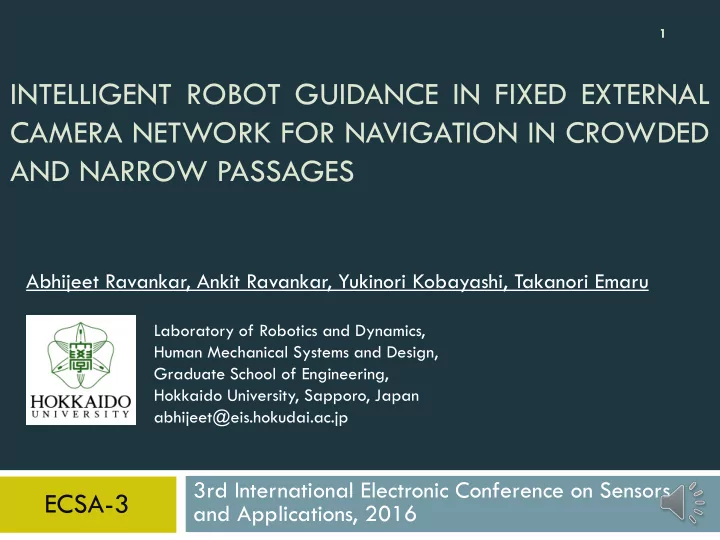

1 INTELLIGENT ROBOT GUIDANCE IN FIXED EXTERNAL CAMERA NETWORK FOR NAVIGATION IN CROWDED AND NARROW PASSAGES Abhijeet Ravankar, Ankit Ravankar, Yukinori Kobayashi, Takanori Emaru Laboratory of Robotics and Dynamics, Human Mechanical Systems and Design, Graduate School of Engineering, Hokkaido University, Sapporo, Japan abhijeet@eis.hokudai.ac.jp 3rd International Electronic Conference on Sensors ECSA-3 and Applications, 2016
(c) Abhijeet Ravankar, Hokkaido University, Sapporo, Japan, 3rd International Electronic Conference on Sensors and Applications, 2016 Video Download Information 2 This entire presentation with narration can be downloaded as video from: (40 MB, medium video quality) http://bit.ly/2fbgodt (16 MB, low video quality) http://bit.ly/2eA4T34 In case the link does not work, kindly contact: Abhijeet Ravankar, abhijeetravankar@gmail.com
(c) Abhijeet Ravankar, Hokkaido University, Sapporo, Japan, 3rd International Electronic Conference on Sensors and Applications, 2016 Robots in Ubiquitous Sensor Network 3 SERVICE ROBOTS @roomba @hospi @southmead @kinghtscope Service robot at home and public places are expected to increase in coming years. USN: Collection and utilization of information in real time, and at any-time and any-where USN’s broad idea: There will be sensors able to exchange information with gateways and Perform assigned tasks In coming years, service robots will have to be integrated with USN
(c) Abhijeet Ravankar, Hokkaido University, Sapporo, Japan, 3rd International Electronic Conference on Sensors and Applications, 2016 Problem 1: Limitation of sensor specs 4 Sensors (ex: camera) are mostly ‘forward’ facing Blind about moving entities on the back side Sensors are generally attached at a lower height Blind about far-off obstacles Occlusion causes loss of information Robot is blind about these people Problem of occlusion
(c) Abhijeet Ravankar, Hokkaido University, Sapporo, Japan, 3rd International Electronic Conference on Sensors and Applications, 2016 Problem 2: Deadlock in narrow passages 5 There are narrow passages in warehouses, libraries, etc. Multiple robots cannot simultaneously access narrow passages Causes deadlock Requires intelligent resource sharing and conflict resolve Must consider factors like robot’s task priority, battery life, … Intelligent path planning
(c) Abhijeet Ravankar, Hokkaido University, Sapporo, Japan, 3rd International Electronic Conference on Sensors and Applications, 2016 Example of a narrow passages in library 6
(c) Abhijeet Ravankar, Hokkaido University, Sapporo, Japan, 3rd International Electronic Conference on Sensors and Applications, 2016 Idea: Robots access external camera info 7 Provides a birds-eye view Robot is no longer constrained by sensor spec A resource allocator can be designed using ubiquitous robot location information
(c) Abhijeet Ravankar, Hokkaido University, Sapporo, Japan, 3rd International Electronic Conference on Sensors and Applications, 2016 Power Estimation and Task Priority 8 Power Estimator DB Total power for multiple tasks:
(c) Abhijeet Ravankar, Hokkaido University, Sapporo, Japan, 3rd International Electronic Conference on Sensors and Applications, 2016 Modified Priority Queue 9 Request from robot comes as pair, where • R i : Robot ID • T i : Task Priority • P i : Current Power Level • X i : Current X Coordinate • Y i : Current X Coordinate Emergency • W P : Power Weight • W T : Task Priority Weight • P TH : Threshold Power
(c) Abhijeet Ravankar, Hokkaido University, Sapporo, Japan, 3rd International Electronic Conference on Sensors and Applications, 2016 JSON Request Example 10 Both Robot and Camera Nodes have a JSON parser
(c) Abhijeet Ravankar, Hokkaido University, Sapporo, Japan, 3rd International Electronic Conference on Sensors and Applications, 2016 Flowchart of Path Allocation 11 Person is prioritized 1 1
(c) Abhijeet Ravankar, Hokkaido University, Sapporo, Japan, 3rd International Electronic Conference on Sensors and Applications, 2016 Experiment Setup 12 Sensors and System • Microsoft Kinect Sensor • UHG08LX LRF • Robot Operating System • Ubuntu 14.04 OS SLAM • Mapping: Grid Mapping • Localization: Particle Filter Pioneer P3-DX Turtlebot Raspberry Pi + Camera
(c) Abhijeet Ravankar, Hokkaido University, Sapporo, Japan, 3rd International Electronic Conference on Sensors and Applications, 2016 Results: Narrow Path Sharing 13
(c) Abhijeet Ravankar, Hokkaido University, Sapporo, Japan, 3rd International Electronic Conference on Sensors and Applications, 2016 Results: Robot-view vs External Camera-view 14 External camera-view Robot’s camera -view
(c) Abhijeet Ravankar, Hokkaido University, Sapporo, Japan, 3rd International Electronic Conference on Sensors and Applications, 2016 Assumption: Map Available. Robots Localize VIDEO 15
(c) Abhijeet Ravankar, Hokkaido University, Sapporo, Japan, 3rd International Electronic Conference on Sensors and Applications, 2016 Results: Utilizing External Cam Info VIDEO 16
(c) Abhijeet Ravankar, Hokkaido University, Sapporo, Japan, 3rd International Electronic Conference on Sensors and Applications, 2016 Robot’s Position Estimation in Occlusion 17 Prediction by camera side Kalman Filter
(c) Abhijeet Ravankar, Hokkaido University, Sapporo, Japan, 3rd International Electronic Conference on Sensors and Applications, 2016 Intelligent Path Planning 18 Many waiting robots. Taking Shortest path via alternate long path is more efficient narrow passage
(c) Abhijeet Ravankar, Hokkaido University, Sapporo, Japan, 3rd International Electronic Conference on Sensors and Applications, 2016 Conclusion and Discussion 19 External camera sensor network can provide a lot of relevant information to the robots to do their tasks efficiently. Robots can plan better trajectories and plan optimal paths towards their goal. It’s feasible to design a resource allocator in such sensor network. Resource is not limited to narrow path & can be extended to other resources like docking/charging points. External camera N/W can provide remote information to robots to perform tasks with better efficiency.
THANK YOU 20 Questions, Comments & Research Collaborations abhijeet@eis.hokudai.ac.jp
Recommend
More recommend